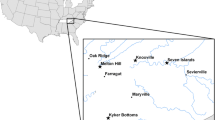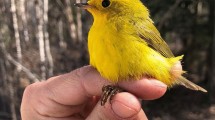Abstract
Long-distance migratory birds are potentially exposed to a range of blood sucking arthropods that transmit avian blood parasites. Because of differential vector exposure, the parasite fauna may vary in different habitat types, among populations, or even within populations where individuals travel to different areas during migration. We applied PCR-based molecular techniques to determine patterns of blood parasite occurrence in adults of seven geographically isolated Bluethroat populations, belonging to three distinct subspecies differing in habitat preferences and wintering areas (Luscinia svecica svecica, L. s. cyanecula, L. s. namnetum). Moreover, to elucidate potential transmission of blood parasites on breeding sites, we tested adults of the relatively sedentary White-throated Dipper (Cinclus cinclus) from a Norwegian population. Across populations, we detected infection of at least one blood parasite genus in 68.5 % (139/203) of adult Bluethroats. The most common parasite genus was Plasmodium (10 lineages, 33.5 % of surveyed individuals), present in all seven populations, followed by Leucocytozoon (four lineages, 31.5 %) and Haemoproteus (two lineages, 4.9 %). We recorded multiple infections in 26.1 % of individuals. Leucocytozoon was found only in svecica inhabiting mountainous/subalpine areas with high abundance of blackflies, the main vector for this parasite. In Plasmodium, two lineages (BT6 and GRW4) were confined to specimens from svecica populations. In contrast, Lineage SGS1 was dominated by southern birds of the subspecies cyanecula and namnetum. Our data suggest transmission of Leucocytozoon on the breeding grounds in Norway as the same lineages were found in relatively sedentary White-throated Dippers as in migratory Bluethroats. We discuss these results in light of the ecological differences between the host populations, affecting their exposure to potential blood parasite vectors.
Zusammenfassung
Die Prävalenz von Blutparasiten beim Blaukehlchen ist verknüpft mit der Unterart und dem Bruthabitat
Langstreckenzieher sind potentiell einer Reihe von blutsaugenden Arthropoden ausgesetzt, die aviäre Blutparasiten übertragen. Da sie Vektoren unterschiedlich stark ausgesetzt sind, kann die Parasitenfaune variieren in verschiedenen Habitattypen, zwischen Population oder sogar innerhalb von Populationen, deren Individuen in unterschiedliche Gebiete ziehen. Zur Anwendung kamen PCR-basierte molekulare Techniken, um die Muster des Auftretens von Blutparasiten adulter Blaukehlchen aus sieben geografisch voneinander isolierten Populationen zu bestimmen. Die untersuchten Individuen gehören zu drei Unterarten, die sich in Habitatpräferenzen und Überwinterungsgebieten unterscheiden (Luscinia svecica svecica, L. s. cyanecula, L. s. namnetum). Zur Aufklärung einer potentiellen Übertragung von Blutparasiten in den Brutgebieten untersuchten wir darüber hinaus als Standvögel adulte Wasseramseln (Cinclus cinclus) einer norwegischen Population. In allen Populationen entdeckten wir eine Infektion mit mindestens einem Blutparasiten-Genus in 68,5 % (139/203) der adulten Blaukehlchen. Der häufigste Parasit, Plasmodium (10 Stämme, 33,5 % der untersuchten Individuen), konnte in allen sieben Populationen nachgewiesen werden. Darauf folgen Leukozytozoon (4 Stämme, 31,5 %) und Haemoproteus (2 Stämme, 4,9 %). Bei 26,1 % der Individuen beobachteten wir Mehrfachinfektionen. Leukozytozoon konnte nur bei ‘svecica-Individuen’ nachgewiesen werden. Diese Unterart besiedelt bergige/subalpine Gebiete mit hohen Dichten von Kriebelmücken, dem Hauptüberträger dieses Parasiten. Bei Plasmodium waren zwei Stämme (BT6 and GRW4) begrenzt auf Exemplare der svecica-Populationen. Im Gegensatz dazu war der Stamm SGS1 dominiert von südlichen Vögeln der Unterarten cyanecula und namnetum. Unsere Daten deuten auf eine Übertragung von Leukozytozoon in den norwegischen Brutgebieten hin, da die gleichen Stämme sowohl bei Wasseramseln als Standvögel als auch in Blaukehlchen als Zugvogelart gefunden wurden. Wir diskutieren diese Ergebnisse im Hinblick auf ökologische Unterschiede zwischen Wirtspopulationen, beeinflusst durch die Gefährdung einer potentiellen Übertragung von Blutparasiten.





Similar content being viewed by others
References
Allander K, Gordon FB (1994) Prevalence and intensity of haematozoan infection in a population of great tits Parus major from Gotland, Sweden. J Avian Biol 25:69–74
Altschul SF, Madden TL, Schäffer AA, Zhang J, Zhang Z, Miller W, Lipman DJ (1997) Gapped BLAST and PSI-BLAST: a new generation of protein database search programs. Nucleic Acids Res 25:3389–3402
Atkinson CT, van Riper C (1991) Pathogenicity and epizootiology of avian haematozoa: Plasmodium, Leucocytozoon and Haemoproteus. In: Loye JE, Zuk M (eds) Bird–parasite interactions, ecology, evolution and behaviour. Oxford University Press, Oxford, pp 19–48
Bakken V, Runde O, Tjørve E (2006) Norwegian bird ringing atlas, vol 2. Stavanger Museum, Stavanger, pp 145–150
Bensch S, Stjernman M, Hasselquist D, Östman Ö, Hansson B, Westerdahl H, Pinheiro RT (2000) Host specificity in avian blood parasites: a study of Plasmodium and Haemoproteus mitochondrial DNA amplified from birds. Proc R Soc Lond B 267:1583–1589
Bensch S, Hellgren O, Pérez-Tris J (2009) MalAvi: a public database of malaria parasites and related haemosporidians in avian hosts based on mitochondrial cytochrome b lineages. Mol Ecol Resour 9:1353–1358
Constant P, Eybert MC (1995) Donnees sur la reproduction et l’hivernage de la gorgebleue Luscinia svecica namnetum. Alauda 63:29–36
Cramp S (ed) (1992) The birds of the western palearctic, vol VI. Oxford University Press, Oxford
del Hoyo J, Elliott A, Christie DA (eds) (2005) Handbook of the birds of the world, vol 10. Cockoos-shrikes to Thrushes, Lynx Edicions
Dunn JC, Cole EF, Quinn JL (2011) Personality and parasites: sex-dependent associations between avian malaria infection and multiple behavioural traits. Behav Ecol Socbiol 65:1459–1471
Ellegren H, Staav R (1990) Blåhakens Luscinia s. svecica flytting-en återfyndsanalys av fåglar märkte i Sverige och Finland. Vår Fågelvärd 49:323–336
Fernández M, Rojo MÁ, Casanueva P, Carrión S, Hernández MÁ, Campos F (2010) High prevalence of haemosporidians in Reed Warbler Acrocephalus scirpaceus and Sedge Warbler Acrocephalus schoenobaenus in Spain. J Ornithol 151:27–32
Hellgren O (2005) The occurrence of haemosporidian parasites in the Fennoscandian Bluethroat (Luscinia svecica) population. J Ornithol 146:55–60
Hellgren O, Waldenström J, Bensch S (2004) A new PCR assay for simultaneous studies of Leucocytozoon, Plasmodium and Haemoproteus from avian blood. J Parasitol 90:797–802
Hellgren O, Wood MJ, Waldenström J, Hasselquist D, Ottosson U, Stervander M, Bensch S (2013) Circannual variation in blood parasitism in a sub-Saharan migrant passerine bird, the garden warbler. J Evol Biol. doi:10.1111/jeb.12129
Johnsen A, Andersson S, Fernandez JG, Kempenaers B, Pavel V, Questiau S, Raess M, Rindal E, Lifjeld JT (2006) Molecular and phenotypic divergence in the bluethroat (Luscinia svecica) subspecies complex. Mol Ecol 15:4033–4047
Knowles SCL, Wood MJ, Sheldon BC (2010a) Context-dependent effects of parental effort on malaria infection in a wild bird population, and their role in reproductive trade-offs. Oecologia 164:87–97
Knowles SCL, Palinauskas V, Sheldon BC (2010b) Chronic malaria infections increase family inequalities and reduce parental fitness: experimental evidence from a wild bird population. J Evol Biol 23:557–569
Korpimaki E, Hakkarainen H, Bennett GF (1993) Blood parasites and reproductive success of Tengmalm Owls—detrimental effects on females but not on males. Funct Ecol 7:420–426
Kulma K, Low M, Bensch S, Qvarnström A (2013) Malaria infections reinforce competitive asymmetry between two Ficedula flycatchers in a recent contact zone. Mol Ecol 22:4591–4601
Lachish S, Knowles SCL, Alves R, Wood MJ, Sheldon BC (2011) Infection dynamics of endemic malaria in a wild bird population: parasite species-dependent drivers of spatial and temporal variation in transmission rates. J Anim Ecol 80:1207–1216
Latta SC, Ricklefs RE (2010) Prevalence patterns of avian haemosporida on Hispaniola. J Avi Biol 41:25–33
Loiseau C, Harrigan RJ, Robert A, Bowie RCK, Thomassen HA, Smith TB, Sehgal RNM (2011) Host and habitat specialization of avina malaria in Africa. Mol Ecol. doi:10.1111/j.1365-294X.2011.05341.x
Marzal A, Bensch S, Reviriego M, Balbontin J, de Lope F (2008) Effects of malaria double infection in birds: one plus one is not two. J Evol Biol 21:979–987
Merino S, Moreno J, Sanz JJ, Arriero E (2000) Are avian blood parasites pathogenic in the wild? A medication experiment in blue tits (Parus caeruleus). Proc R Soc B 267:2507–2510
Ortego J, Cordero PJ, Aparicio MJ, Calabuig G (2008) Consequences of chronic infections with three different avian malaria lineages on reproductive performance of Lesser Kestrels (Falco naumanni). J Ornithol 149:337–343
Ots I, Horak P (1998) Health impact of blood parasites in breeding great tits. Oecologia 116:441–448
Paradis E, Claude J, Strimmer K (2004) APE: analyses of phylogenetics and evolution in R language. Bioinformatics 20:289–290
Reullier J, Perez-Tris J, Bensch S, Secondi J (2006) Diversity, distribution and exchange of blood parasites meeting at an avian moving contact zone. Mol Ecol 15:753–763
R Core Team (2012) R: A language and environment for statistical computing. R Foundation for Statistical Computing, Vienna, Austria. ISBN 3-900051-07-0. http://www.R-project.org/
Schliep KP (2011) Phangorn: phylogenetic analysis in R. Bioinformatics 27:592–593
Seutin G, White BN, Boag PT (1991) Preservation of avian blood and tissue samples for DNA analyses. Can J Zool 69:82–90
Shurulinkov P, Golemansky V (2002) Haemoproteids (Haemoproteida: Haemoproteidae) of wild birds in Bulgaria. Acta Protozool 41:359–374
Shurulinkov P, Ilieva M (2009) Spatial and temporal differences in the blood parasite fauna of passerine birds during the spring migration in Bulgaria. Parasitol Res 104:1453–1458
Svensson L (1992) Identification Guide to European Passerines, 4th edn. British Trust for Ornithology
Svoboda A, Marthinsen G, Turcokova L, Lifjeld JT, Johnsen A (2009) Identification of blood parasites in old world warbler species from the Danube river delta. Avian Dis 53:634–636
Szoellosi E, Cichon M, Eens M, Hasselquist D, Kempenaers B, Merino S, Nilsson JA, Rosivall B, Rytkonen S, Torok J, Wood MJ, Garamszegi LZ (2011) Determinants of distribution and prevalence of avian malaria in blue tit populations across Europe: separating host and parasite effects. J Evol Biol 24:2014–2024
Ventim R, Morais J, Pardal S, Mendes L, Ramos JA, Péres-Tris J (2012) Host–parasite associations and host-specificity in haemoparasites of reed bed passerines. Parasitology 139:310–316
Waldenström J, Bensch S, Kiboi S, Hasselquist D, Ottosson U (2002) Cross-species infection of blood parasites between resident and migratory songbirds in Africa. Mol Ecol 8:1545–1554
Waldenström J, Bensch S, Kiboi S, Hasselquist D, Ostman O (2004) A new nested polymerase chain reaction method very efficient in detecting Plasmodium and Haemoproteus infections from avian blood. J Parasitol 90:191–194
Yohannes E, Hansson B, Lee RW, Waldenström J, Westerdahl H, Akesson M, Hasselquist D, Bensch S (2008) Isotope signatures in winter moulted feathers predict malaria prevalence in a breeding avian host. Oecologia 158:299–306
Yohannes E, Krizanauskiene A, Valcu M, Bensch S, Kempenaers B (2009) Prevalence of malaria and related haemosporidian parasites in two shorebird species with different winter habitat distribution. J Ornithol 150:287–291
Zink RM, Drovetski SV, Questiau S, Fadeev IV, Nesterov EV, Westberg MC, Rohwer S (2003) Recent evolutionary history of the bluethroat (Luscinia svecica) across Eurasia. Mol Ecol 12:3069–3075
Zucca M, Jiguet F (2002) Status of bluethroat in France: breeding, migration and wintering. Ornithos 9:242–252
Acknowledgments
We thank Hotel Luční bouda and the Administration of the Krkonoše National Park for their help with arranging the authors' stay in Krkonoše Mts. We are grateful to the Royal Swedish Academy of Sciences (Abisko Scientific Research Station) and to Natalia Iovchenko (Saint Petersburg State University, Russian Federation) for logistic support, and to Sophie Questiau for providing blood samples from the namnetum population. Special thanks to Jarl A. Anmarkrud, Trond Øigarden, Oddmund Kleven, Anders Herfoss and Petr Nádvorník for their advices and help with lab work. Blood sampling was performed with permission from the relevant national authorities. Funding for this research was supplied by grants of the Ministry of Education, Youth, and Sports of the Czech Republic (MSM6198959212), by the Faculty of Science of Palacky University, the Research Council of Norway and the National Centre for Biosystematics, University of Oslo, Norway.
Author information
Authors and Affiliations
Corresponding author
Additional information
Communicated by K. C. Klasing.
Rights and permissions
About this article
Cite this article
Svoboda, A., Marthinsen, G., Pavel, V. et al. Blood parasite prevalence in the Bluethroat is associated with subspecies and breeding habitat. J Ornithol 156, 371–380 (2015). https://doi.org/10.1007/s10336-014-1134-9
Received:
Revised:
Accepted:
Published:
Issue Date:
DOI: https://doi.org/10.1007/s10336-014-1134-9




